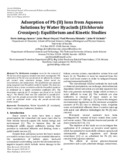| dc.contributor.author | Anzeze, Davis Amboga | |
| dc.contributor.author | Onyari, John Mmari | |
| dc.contributor.author | Shiundu, PM | |
| dc.contributor.author | Gichuki, John W | |
| dc.date.accessioned | 2015-06-14T07:38:44Z | |
| dc.date.available | 2015-06-14T07:38:44Z | |
| dc.date.issued | 2014 | |
| dc.identifier.citation | International Journal of Environmental Pollution and Remediation Volume 2, Year 2014 | en_US |
| dc.identifier.uri | http://ijepr.avestia.com/2014/013.html | |
| dc.identifier.uri | http://hdl.handle.net/11295/84755 | |
| dc.description.abstract | The Eichhornia crassipes roots for the removal of Pb (II) ions from aqueous solutions has been investigated. The adsorption of Pb (II) ions was found to be affected by solution pH, contact time, adsorbent dosage, initial metal ion concentration, and temperature. The equilibrium was analysed using Langmuir and Freundlich isotherm models. The data was found to have a closer correlation with the Freundlich isotherm as evidenced by a higher correlation coefficient (R2). The biosorption capacity for E. crasippes was found to be 16.350 mg g-1. The Kinetics data was also subjected to pseudo-first-order and the pseudo-second-order kinetic models. The data could be explained better using the pseudo-second-order kinetic model. | en_US |
| dc.language.iso | en | en_US |
| dc.subject | Biosorption | en_US |
| dc.subject | Water hyacinth (E. crassipes) | en_US |
| dc.subject | Heavy metal ions | en_US |
| dc.subject | Isotherms | en_US |
| dc.subject | Kinetics | en_US |
| dc.title | Adsorption of Pb (II) Ions from Aqueous Solutions by Water Hyacinth (Eichhornia Crassipes): Equilibrium and Kinetic Studies | en_US |
| dc.type | Article | en_US |
| dc.type.material | en_US | en_US |

